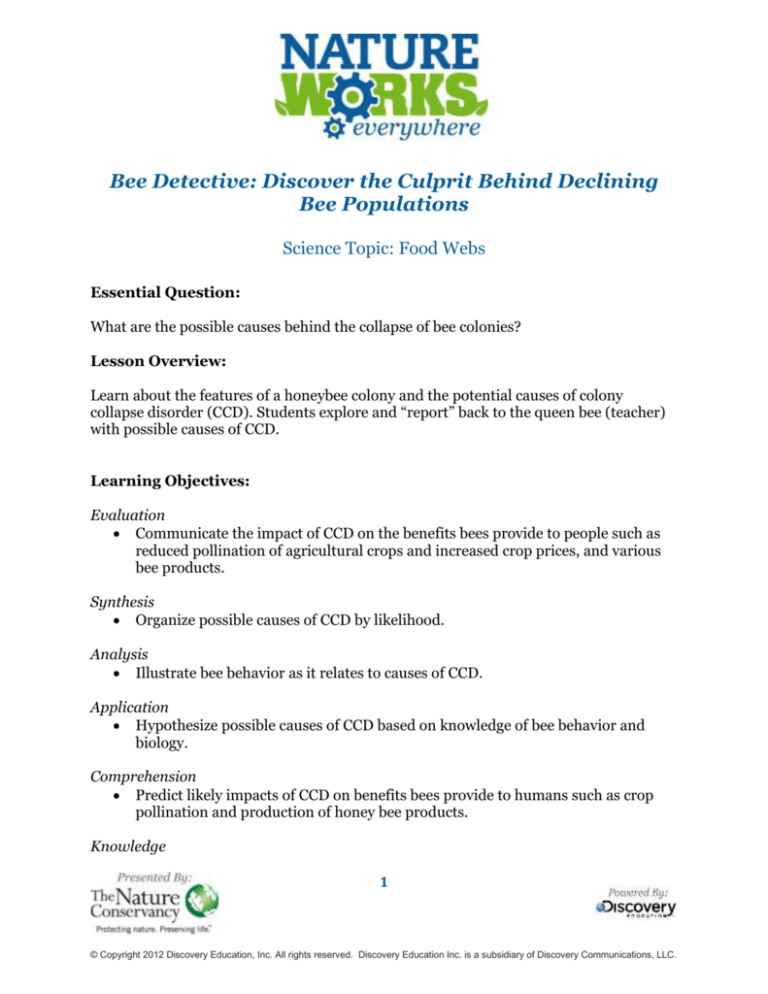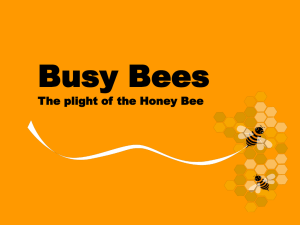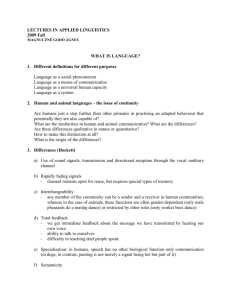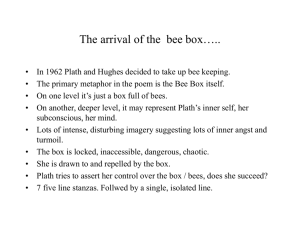
Bee Detective: Discover the Culprit Behind Declining
Bee Populations
Science Topic: Food Webs
Essential Question:
What are the possible causes behind the collapse of bee colonies?
Lesson Overview:
Learn about the features of a honeybee colony and the potential causes of colony
collapse disorder (CCD). Students explore and “report” back to the queen bee (teacher)
with possible causes of CCD.
Learning Objectives:
Evaluation
Communicate the impact of CCD on the benefits bees provide to people such as
reduced pollination of agricultural crops and increased crop prices, and various
bee products.
Synthesis
Organize possible causes of CCD by likelihood.
Analysis
Illustrate bee behavior as it relates to causes of CCD.
Application
Hypothesize possible causes of CCD based on knowledge of bee behavior and
biology.
Comprehension
Predict likely impacts of CCD on benefits bees provide to humans such as crop
pollination and production of honey bee products.
Knowledge
1
© Copyright 2012 Discovery Education, Inc. All rights reserved. Discovery Education Inc. is a subsidiary of Discovery Communications, LLC.
Describe key features of honey bee behavior and biology, and identify causes of
CCD.
Know that honeybees benefit humans as
o Important pollinators of food crops.
o Producers of honey and beeswax.
o A tradition of bee-keeping dating back thousands of years.
Nature Works Everywhere Themes:
Food: Bees produce honey, a widely used ingredient in some foods
Stuff: Beeswax has a wide range of domestic and industrial uses
Memories: The practice of bee-keeping goes back to antiquity
Next Generation Science Standards - Middle School:
LS1-4: Use argument based on empirical evidence and scientific reasoning to
support an explanation for how characteristic animal behaviors and specialized
plant structures affect the probability of successful reproduction of animals and
plants respectively.
LS1-5: Construct a scientific explanation based on evidence for how
environmental and genetic factors influence the growth of organisms.
LS2-1: Analyze and interpret data to provide evidence for the effects of resource
availability on organisms and populations of organisms in an ecosystem.
LS2-2: Construct an explanation that predicts patterns of interactions among
organisms across multiple ecosystems.
LS2-4: Construct an argument supported by empirical evidence that changes to
physical or biological components of an ecosystem affect populations.
LS2-5: Evaluate competing design solutions for maintaining biodiversity and
ecosystem services.
LS4-4: Construct an explanation based on evidence that describes how genetic
variations of traits in a population increase some individuals’ probability of
surviving and reproducing in a specific environment.
LS4-5: Gather and synthesize information about the technologies that have
changed the way humans influence the inheritance of desired traits in organisms.
ES3-2: Analyze and interpret data on natural hazards to forecast future
catastrophic events and inform the development of technologies to mitigate their
effects.
2
© Copyright 2012 Discovery Education, Inc. All rights reserved. Discovery Education Inc. is a subsidiary of Discovery Communications, LLC.
ES3-3: Apply scientific principles to design a method for monitoring and
minimizing a human impact on the environment.
ES3-4: Construct an argument supported by evidence for how increases in
human population and per-capita consumption of natural resources impact
Earth’s systems.
Next Generation Science Standards - High School:
HS-LS2-2. Use mathematical representations to support and revise
explanations based on evidence about factors affecting biodiversity and
populations in ecosystems of different scales.
HS-LS2-6. Evaluate the claims, evidence, and reasoning that the complex
interactions in ecosystems maintain relatively consistent numbers and types of
organisms in stable conditions, but changing conditions may result in a new
ecosystem.
HS-LS2-7. Design, evaluate, and refine a solution for reducing the impacts of
human activities on the environment and biodiversity.*
HS-LS4-2. Construct an explanation based on evidence that the process of
evolution primarily results from four factors: (1) the potential for a species to
increase in number, (2) the heritable genetic variation of individuals in a species
due to mutation and sexual reproduction, (3) competition for limited resources,
and (4) the proliferation of those organisms that are better able to survive and
reproduce in the environment.
HS-LS4-5. Evaluate the evidence supporting claims that changes in
environmental conditions may result in: (1) increases in the number of
individuals of some species, (2) the emergence of new species over time, and (3)
the extinction of other species.
HS-ESS3-1. Construct an explanation based on evidence for how the availability
of natural resources, occurrence of natural hazards, and changes in climate have
influenced human activity.
HS-ETS1-1. Analyze a major global challenge to specify qualitative and
quantitative criteria and constraints for solutions that account for societal needs
and wants.
3
© Copyright 2012 Discovery Education, Inc. All rights reserved. Discovery Education Inc. is a subsidiary of Discovery Communications, LLC.
HS-ETS1-2. Design a solution to a complex real-world problem by breaking it
down into smaller, more manageable problems that can be solved through
engineering.
HS-ETS1-3. Evaluate a solution to a complex real-world problem based on
prioritized criteria and trade-offs that account for a range of constraints,
including cost, safety, reliability, and aesthetics, as well as possible social,
cultural, and environmental impacts.
Time Frame:
This lesson can be completed in two 45 minute sessions.
Vocabulary:
Pollinator: Organism such as a honeybee that visits flowers, resulting in
pollination
Colony collapse: Sudden demise of a honeybee colony
Mite: A tiny arachnid with four pairs of legs, related to spiders
Eusociality: Social behavior among a group of related organisms in which
nonbreeding individuals care for young
Apiary: A group of beehives, cared for by an apiarist
Nature Works Everywhere videos that support this lesson plan:
Pollinators – Putting Food on the Table introductory video
glossary terms video
close-up of bees entering a hive
interior of hive
Background for the Teacher:
In this lesson plan, students study the widely reported loss of bees declining because of
colony collapse disorder (CCD). Since bees provide vital benefits to people, including
crop pollination, and products such as honey and beeswax, the loss of bee colonies
through CCD is a serious concern.
The activity puts students at the cutting edge of science research because to date, CCD
has not been reliably attributed to any single cause. The aim is for students to
4
© Copyright 2012 Discovery Education, Inc. All rights reserved. Discovery Education Inc. is a subsidiary of Discovery Communications, LLC.
understand that in nature, simple cause-effect relationships may not explain all our
observations. In this way, students learn that science is an investigative process, not
simply a way to describe nature.
Thus, a variety of clues are presented that lead students to conclude that CCD results
from a combination of factors. To make the activities more engaging, the students can
play the role of worker bees. The teacher is the queen bee. The worker bees report the
results of their research to the queen. If needed, review the roles of the different castes
in the bee colony. Key points:
The queen lays eggs and provides chemical cues to direct the colony’s behavior. If
the queen dies, the colony cannot survive.
The workers are all sterile females and perform all the chores of the colony such
as tending larvae, getting food for the colony, building the wax honeycombs and
defending the colony.
Drones are males and their only role is to mate with new queens so that the
colony can reproduce.
Scientific findings to date suggest that external factors prevent workers from returning
to the hive, which is the proximate cause of CCD. Related or causal factors include:
Bees bring back pollen treated with chemicals, bacterial infections, fungus or
mites from nearby colonies. Such pollen serves as a vector for disease or toxins
within the hive.
A loss of habitat can result in malnutrition for larvae, such as mineral
deficiencies.
Infection of bees with the Varroa mite (which feeds off the lymphatic tissue of
adult bees) is implicated in many, but not all, cases of CCD.
Some studies suggest that electromagnetic radiation interferes with a bee’s
navigation, preventing them from returning to the hive. Therefore, the increase in
cell-phone use may be a cause of CCD.
Key statistics related to CCD (to use in lesson)
U.S. beekeepers lost more than a third of all their hives in the three years from
2006 to 2009.
Honey bees are the main pollinators of agricultural crops, providing pollination
for crops valued at up to $20 billion annually.
About a third of the U.S. diet comes from foods that involve pollination by honey
bees.
5
© Copyright 2012 Discovery Education, Inc. All rights reserved. Discovery Education Inc. is a subsidiary of Discovery Communications, LLC.
Beekeepers normally lose some colonies, but the recent declines are much greater
than in previous years.
Colony failure in recent years is characterized by bees failing to return to hives,
but this behavior is abnormal and its cause is unknown.
CCD has been reported in more than 35 states and many other countries.
Media articles (print out for lesson)
http://money.cnn.com/2007/03/29/news/honeybees/
http://www.dailymail.co.uk/sciencetech/article-1385907/Why-mobile-phone-ringmake-bees-buzz-Insects-infuriated-handset-signals.html
http://www.spiegel.de/international/world/0,1518,473166,00.html
http://news.bbc.co.uk/2/hi/science/nature/8467746.stm
http://www.sciencedaily.com/releases/2005/05/050517110843.htm
http://www.planetark.com/dailynewsstory.cfm/newsid/43163/story.htm
http://articles.latimes.com/2007/apr/26/science/sci-bees26
http://www.nytimes.com/2007/09/07/science/07bees.html
Classroom Activity:
Materials
For each group of students:
Computer with Internet connection (or can be executed with one computer and
interactive board in the class)
Printouts of media articles related to CCD
Engage
1. Bring a variety of fruits such as apples, pears and cherries, and nuts* to class.
(*Use photos of nuts if regulations do not permit nut products in school.)
2. Bite into an apple, and ask students how an apple grows.
3. Show students the introductory video Pollinators – Putting Food on the Table
(http://vimeo.com/77811127) that demonstrates how a picnic would be thin fare
without bees.
4. Lead students to the conclusion that apples and many fruit crops grow on trees
from flowers pollinated by bees. This will emphasize the importance of bees to
agriculture in their role as pollinators.
5. Use the whiteboard to help students complete a list of how bees are vital to the
ecosystem. Possible reasons include:
Bees depend on flowers and the plant's existence in turn depends on bees.
6
© Copyright 2012 Discovery Education, Inc. All rights reserved. Discovery Education Inc. is a subsidiary of Discovery Communications, LLC.
6.
7.
8.
9.
When bees get pollen and nectar from flowers, they pollinate or fertilize the
plant. Plants then can produce their own fruits and seeds.
Bees are the primary or only source of pollination for many plants.
Fruits resulting from pollination by bees are consumed by many birds, insects
and other animals.
Honey is food for wild animals
Tell students that a place where bees are raised is called an apiary, where
beehives are cared for by an apiarist.
Show video of bees entering hive (http://vimeo.com/39224539) and interior of
hive (http://vimeo.com/39224562).
Present statistics highlighting colony collapse disorder, such as U.S. beekeepers
losing more than a third of all their hives in 2007. Similar problems are reported
from Europe and elsewhere.
Have students brainstorm to list crops pollinated by honeybees, evaluate the
consequences of such losses, and thereby see the urgency of understanding the
causes of CCD.
Explore
1. Students investigate possible causes of CCD by learning about honeybee biology
and ecology. Have students learn about:
a. Hive activities including social behavior, caste structure (workers, queen,
drones), hive management and honeycomb architecture.
b. Pollination activity including visiting flowers
c. Environmental factors related to mortality including predators,
temperature, exposure to radiation (cell phones) and pesticides
2. Have the class brainstorm to list factors that cause the death of honeybees.
3. Encourage students to hypothesize on factors that could lead to CCD, i.e., higher
death rates than usual (for example, predators are an unlikely cause of CCD since
there is no evidence the number of predators has increased).
4. Have them make a list of possible causes of CCD based on causes of bee death.
5. Divide students into small groups. Each group must choose one possible cause
from the list in Step 5 as a hypothesis and then test the hypothesis with evidence
from the literature. Give each group access to the media articles and online
resources on honeybee biology.
6. Have each group present the results of their findings to the class.
7. In particular, encourage students to discuss mites as a cause of CCD, since these
are implicated in many incidents of CCD.
8. Have each group of students hypothesize the relative importance of each factor.
For example, cell phone use might be a less important cause in areas where there
7
© Copyright 2012 Discovery Education, Inc. All rights reserved. Discovery Education Inc. is a subsidiary of Discovery Communications, LLC.
are few cell phones, compared to use of pesticides, which are widely used. The job
of each group is to develop a ranked list of possible causes from most to least
likely.
9. Have groups report to the teacher with their compiled list of possible causes.
10. The students can help the teacher to compile each of their lists to see where there
is consensus, and to develop an overall ranked list.
11. Have students use the whiteboard to create their list of possible causes of CCD
and hypothesize on the likelihood of each factor being the cause of CCD based on
their investigation in the Explore section. (Don’t worry if they don’t emerge with
one single answer. The causes of CCD are still unclear. The aim is to help them
think critically about evaluating possible causes.)
12. Have students rank the likelihood of possible causes based on the consensus list
(Step 10 above).
Explain
1. Have students research the concept of eusociality, so that they can explain that
honeybees are social insects with colonies comprising numerous non-breeding
individuals that take care of young as directed by a breeding female.
2. Ensure that students can describe how bees are vital to natural ecosystems and
human agriculture. Students should be able to make the connection that future
production of many crops as well as wild plant communities depends on the
health and sustainability of bee colonies.
3. Students should be able to articulate that if we can understand the causes of CCD,
we can implement measures to ameliorate the impact of honeybee population
declines.
4. Have students discuss the list of possible causes of CCD and hypothesize on most
likely scenarios based on their investigation in the Explore section.
5. Have students rank the likely impact of possible causes based on the consensus
list (Step 10 in the Explore section).
Extend
1. Have students read the printouts of media articles and review them to relate their
possible causes of CCD with those that are reported in the media.
2. Discuss the role of genetics as a factor. For example, colonies derived from a
single ancestral colony may be equally susceptible to diseases or parasites.
Colonies derived from crossing unrelated ancestral colonies may be less
susceptible to diseases or parasites.
3. Have students hypothesize possible solutions to each of their selected factors.
8
© Copyright 2012 Discovery Education, Inc. All rights reserved. Discovery Education Inc. is a subsidiary of Discovery Communications, LLC.
4. Have students brainstorm other industries that are impacted by loss of
honeybees, such as beeswax and honey production.
5. Have students create a short article for a school or local website that highlights
the benefits of honeybees and the threat of CCD.
6. Have students research to find the earliest recorded beekeeping in history.
Another exercise could include finding mentions of beekeeping in popular
literature (such as Sherlock Holmes retiring to a life as a beekeeper) and other
notable mentions of beekeeping, bees or honey (see Additional Resources).
7. Students could visit a local apiarist to learn firsthand the challenges of
beekeeping.
8. Have students create a concept map of how bees benefit wild plant communities,
such as pollinating rare or endangered plants.
Evaluate
Students will be evaluated on the quality of their ideas, and their ability to attribute a
cause. The aim is for students to discern that there sometimes is no simple answer to
explain a biological observation. Specific questions:
1. Why will a decline in the number of bees affect the health of the bee colony?
2. What will be the effect on yields of food crops such as fruits and nuts if the
number of colonies declines? Explain.
3. How is the decline of bees likely to affect the prices of fresh fruits and other foods
in the supermarket?
4. If a bee colony with 50,000 bees loses 30 percent of its bees during one winter,
how many bees will survive that winter?
5. Draw a simple graph to estimate how long it would take for the bee colony to
collapse completely (less than 10,000 bees) if it lost 30 percent of its bees every
winter, and gained only 5 percent each spring.
Scoring key for evaluation
1. If the number of bees declines, there are fewer workers to bring food to
developing young. The queen can continue to lay eggs, but fewer larvae will
mature. Such a colony is less able to survive natural fluctuations in worker
numbers caused by cold weather, and by hive pests or parasites.
2. If the number of colonies declines, fewer flowers will be pollinated. This, in turn,
means that plants will form fewer fruits. Yields of food crops will be lower as a
result.
3. If bees decline, crop harvests are lower so there is less food available for sale.
Therefore prices of fresh fruits and other foods in the supermarket will increase.
4. Since 30% of 50,000 = 15,000, the number of surviving bees = 35,000 bees.
9
© Copyright 2012 Discovery Education, Inc. All rights reserved. Discovery Education Inc. is a subsidiary of Discovery Communications, LLC.
5. Students should create a simple table as follows. Have students program
formulas into a spreadsheet:
a. Loss = number of bees in winter x 30%
b. Gain = number of bees in spring x 5%
c. Number of bees in winter = Number of bees in spring + gain (except
winter in year 1)
d. Number of bees in spring = Number of bees in winter - loss
Therefore it would take 6 years for the colony to collapse to less than 10,000 bees.
Year Season Number of bees Loss Gain
1
Winter
50,000 15000
Spring
35,000
1750
2
Winter
36,750 11025
Spring
25,725
1286
3
Winter
27,011
8103
Spring
18,908
945
4
Winter
19,853
5956
Spring
13,897
695
5
Winter
14,592 4378
Spring
10,215
511
6
Winter
10,725
3218
Spring
7,508
375
10
© Copyright 2012 Discovery Education, Inc. All rights reserved. Discovery Education Inc. is a subsidiary of Discovery Communications, LLC.
EXAMPLE GRAPH
Additional resources and further reading
http://www.nature.org/ourinitiatives/regions/northamerica/unitedstates/indiana/jour
neywithnature/bees-agriculture.xml
http://www.fas.org/sgp/crs/misc/RL33938.pdf
http://www.honey.com/nhb/home/
http://reshafim.org.il/ad/egypt/timelines/topics/beekeeping.htm
http://www.beeculture.com/content/StateApiaristDirectory/
http://www.ars.usda.gov/main/site_main.htm?modecode=53-42-03-00
http://www.badbeekeeping.com/fame.htm
http://www.iowalivingroadway.com/ResearchProjects/90-00-LRTF-011.pdf
N. Gallai, J. Sales, et al. 2009. Economic valuation of the vulnerability of world
agriculture confronted with pollinator decline. Ecological Economics 68: 810-821
Roulston, T. and K. Goodell (2011) The Role of Resources and Risks in Regulating Wild
Bee Populations. Annual Review of Entomology 56: 293-312. DOI: 10.1146/annurevento-120709-144802
11
© Copyright 2012 Discovery Education, Inc. All rights reserved. Discovery Education Inc. is a subsidiary of Discovery Communications, LLC.








